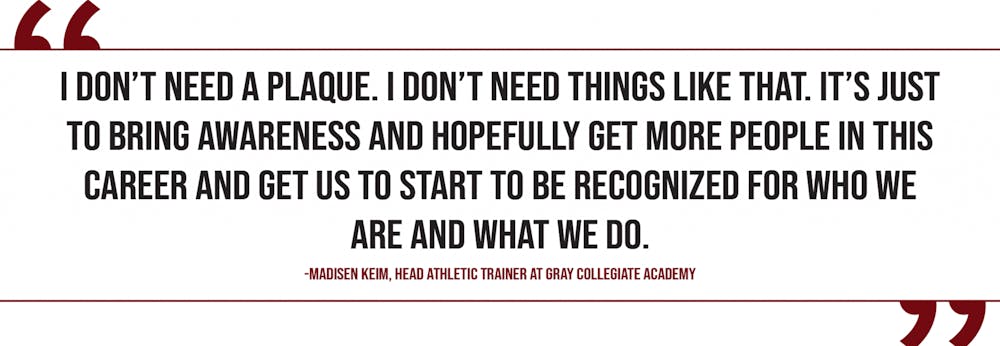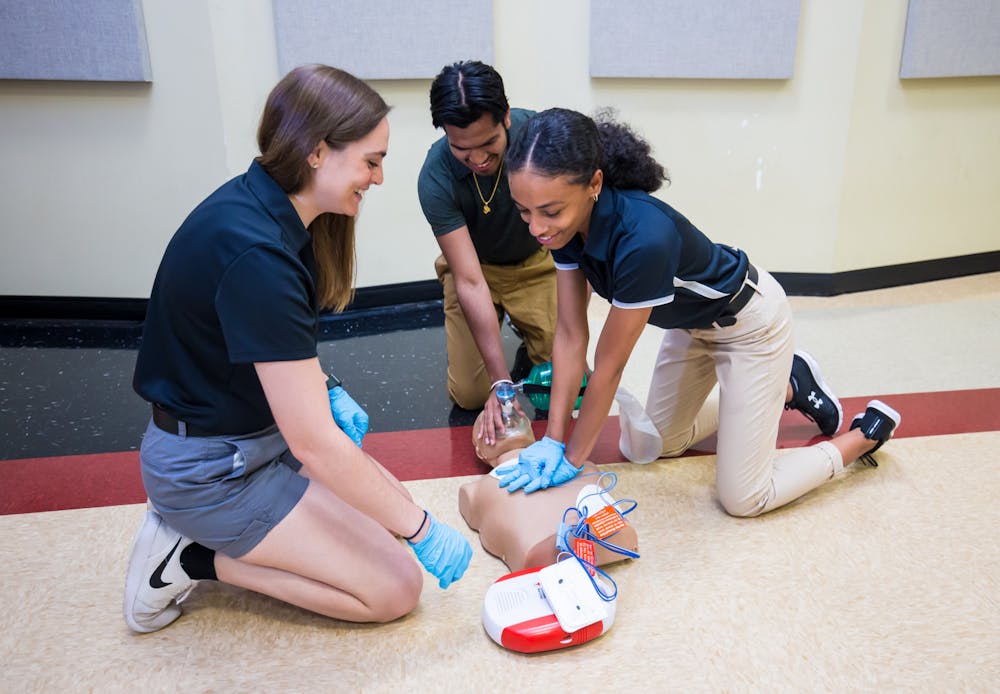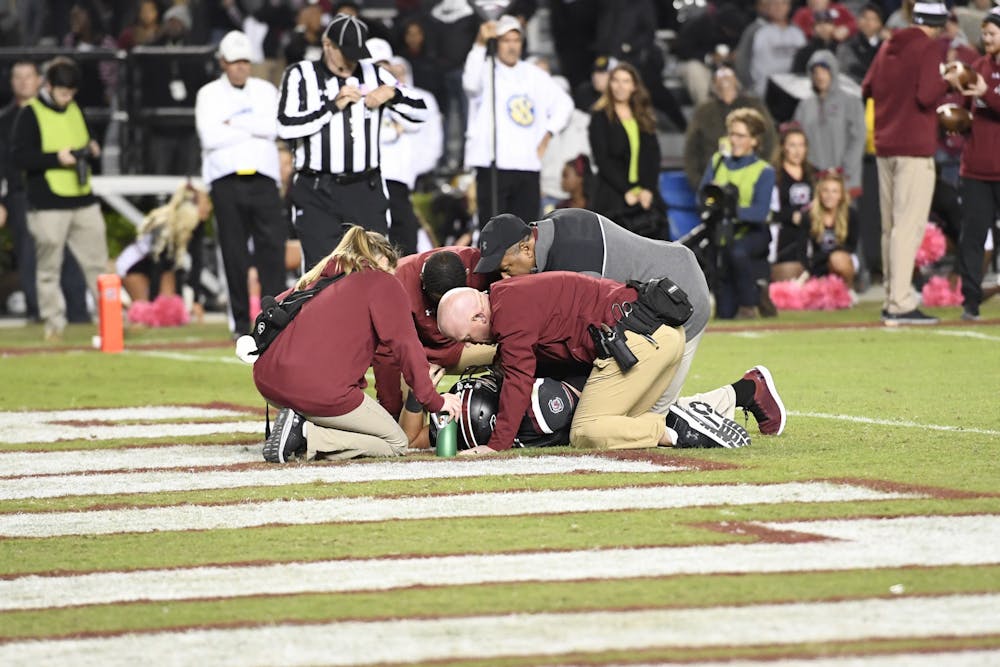Before Gray Collegiate Academy’s varsity boys’ basketball team took the court against W.J. Keenan on Jan. 17, head athletic trainer Madisen Keim spent additional time reviewing emergency protocols for the school’s new indoor arena with her athletic training student.
“I’m prepared for this type of event – I have been since I became CPR certified as a freshman in college – but you never think it’s going to be you that has to be the one to jump into action,” Keim said.
Later that night, a Gray Collegiate Academy basketball player took a hard fall and began having a seizure on the court with seconds left in the game. He stopped breathing during the seizure, which prompted Keim and her student to implement the emergency plan they discussed hours earlier.
Keim, an alunmnus of South Carolina's graduate athletic training program, said administering CPR “felt like an eternity," but after around 20 compressions, she resuscitated the player without using an automated external defibrillator.
While the time she spent performing CPR was short, Keim said the mental effects of her emergency response lingered as she resumed her regular duties the next day.
“It was hard to sleep because every time I closed my eyes, I saw the athlete’s face," Keim said. “Every time that somebody said, ‘Thank you’ or ‘You’re amazing. You saved his life,' whatever it was, it kind of just re-brought it back up, so you couldn’t get away from it.”
Two weeks later, the player whose life she saved made his return to the court on Jan. 31. Keim, along with the rest of Gray Collegiate Academy's athletic training staff, were honored in a halftime ceremony.
“Seeing him back on the court was the best reward I could have ever received," Keim said. "You never want to see something taken away from such a young person — let alone potentially their life — so to see him back on the court doing what he loves and what he plans to do in college and going on in life, that was the best thing that could’ve happened for me.”
Keim's emergency situation drew similarities to one that took place just over two weeks earlier and garnered national attention. In a regular season NFL game against the Cincinnati Bengals on Jan. 2, Buffalo Bills safety Damar Hamlin fell to the ground after making a routine tackle and went into cardiac arrest.
Members of the Bills’ athletic training staff ran onto the field and administered CPR on Hamlin for over eight minutes before he was transported to the University of Cincinnati Medical Center, where he spent a week in the hospital’s intensive care unit. Since then, he has made a full recovery and was officially cleared to resume full football activities on April 18.
Keim said she hopes her story helps people better understand the valuable role athletic trainers play in daily life.
“Right now, the world, and I guess the U.S. in general, is on edge and is realizing what athletic trainers are and what we do day-to-day," Kiem said. "I don’t need a plaque. I don’t need things like that. It’s just to bring awareness and hopefully get more and more people in this career and get us to start to be recognized for who we are and what we do."

More than just “taping ankles”
Part of understanding the role athletic trainers play is knowing what they do outside of evaluating athletes’ injuries. Kelsey Stranc, an athletic trainer with South Carolina’s cross country and track and field teams, said her job requires her to "wear many hats."
“On the surface, it appears that we’re the ones just handing out water bottles and taping ankles, and it’s so much deeper than that,” Stranc said.
For starters, athletic trainers must always be prepared for emergencies. South Carolina's head football trainer, Clint Haggard, said he and his staff practice emergency situations five to six times per year in a number of places, such as the team’s practice facility, weight room, administrative buildings and Williams-Brice Stadium.
Haggard also said he has emergency action plans for every location the team visits, including hotels and stadiums.
Beyond emergency response, Stranc is responsible for numerous administrative duties for the athletic department, such as filing insurance paperwork and keeping accurate records of athletes’ medical histories. She also communicates with a number of entities, including team physicians, academic staff, the media, team coaches and the strength and conditioning staff, as part of her day-to-day schedule.
In many cases, Stranc’s support of student-athletes extends further than medical recommendations, as she occasionally provides emotional support when athletes experience difficult situations. At last year’s SEC Outdoor Track and Field Championships, she spent time in the hospital comforting an athlete who was hit by a car outside Ole Miss’ track and field facility and suffered severe spine and leg injuries.
“When I got back to where he was, he was in a cervical collar. They were still cleaning up blood on him, and he was pretty shaken up. He was in a lot of shock at that point,” Stranc said. “I was holding his hand, talking to him (and) reassuring him that they were going to take really good care of him.”
Haggard said he considers himself a “confidante” who tries get to know his players on a personal level.
“When the guys are struggling with their girlfriends, or struggling in class or struggling in life, we’re the ones that they come to to talk about with that kind of stuff,” Haggard said. “There’s a lot of times that I have guys that sit in my office and want to talk for a while, and they just want to get something off their chest.”
Trust is the key to developing strong relationships with his players, he said.
"For them to feel comfortable doing that, you’ve got to build that relationship and build that trust with them, and then they know you’re the person they can go to for anything,” Haggard said.
The next generation
Athletic training has been a field of study at South Carolina for only a brief part of the university's long history, with its origins dating back to the late 1990s. Over the last few decades, South Carolina has become a premier location for the next generation of athletic training students to attend school, according to Zachary Winkelmann, a clinical education coordinator within the Arnold School of Public Health.
“USC’s pretty innovative in terms of how we’re helping with athletic training,” Winkelmann said. “We’re often seen as one of the big places to go for athletic training school.”

The university currently offers two graduate degrees in athletic training. The Master of Science in Athletic Training — known as the “Professional Program” — is for students working towards earning a certification in athletic training.
After earning a certification in athletic training, they can apply to the Master of Science in Advanced Athletic Training — known as the “'Post-Professional Program” — which focuses on advanced studies and helping students transition into post-professional practice.
Jim Mensch, the director of the Professional Athletic Training Program, said the goal of the program is to provide help students prepare to become athletic trainers.
As part of the program, students take part in experiential learning opportunities, both in the classroom and at Prisma Health’s Simulation Center, along with their coursework.
“We run a simulation there every year where there’s also basketball game noise playing over the speakers, so the environment feels the same," Amy Fraley Hand, the clinical education coordinator for South Carolina’s Professional Athletic Training Program, said. "Then, we stop and we debrief it and go, ‘Okay, how could that have gone better? Okay, let’s run it again,’ and so every single time, we’re just getting better at it to where it becomes second nature and you’re able to just respond.”
Incorporated into the program is an immersive clinical experience, where students gain first-hand knowledge and skills in a professional setting.
Keim, who did her clinicals at Gray Collegiate Academy before being hired full-time there years later, said her clinical experience served as a valuable learning opportunity for her.
“Being able to have two years of certified experience while still earning another degree … I think that’s one of the best experiences you can have as an athletic trainer because you can learn in the classroom, but the things you’re going to learn the most are out in the field," Klein said.
Mensch said these clinical experiences also allow students to develop versatility by working in settings that have less access to medical equipment.
“Obviously, you want to get South Carolina’s multi-million dollar athletic department and work with the athletic teams that here that have … all the equipment that you would need, but you also want to have students get an experience at a low socio-economic high school where they don’t have resources or the same kinds of tools, and you still have to treat the athlete, Mensch said.”
In the Post-Professional Program, most of the students' preparation lies in learning how to transition from a student to an athletic training professional.
"We integrate a lot of mentorship throughout that process while they're here for two years and just to help guide them clinically and professionally and to make sure that they're making good clinical decisions so when they're in a position to save a life, they feel confident, they know the skills and they're able to react without getting stressed out," Director of the Post-Professional Athletic Training Program Toni Torres-McGehee said.
Torres-McGehee said alumni of this program have gone on to work for sports organizations around the globe, including NASCAR, the Japanese national basketball team and the NFL. According to Mensch, Gamecock alumni have also made valuable local contributions by increasing access to health care.
“Years ago, high schools didn’t have athletic trainers, or they had one,” Mensch said. “Now, we’re seeing that upwards around 70 (to) 75% of all high schools in the state of South Carolina have an athletic trainer, and lots have two, or three or four.”
Mensch said he also sees the growth of athletic trainers outside of sports as an important trend that will continue in the future.
“It doesn’t matter if it’s a ballet dancer, a soldier or a football player. If they get an injury, they want it taken care of, and they want to get back in the game,” Mensch said. “Those skillsets are transferable, and that’s why I think athletic trainers can have a big impact in health care across the board."

Not just for athletic trainers
Even though athletic trainers have to maintain their CPR certification through biannual hands-on training sessions, everyday people have opportunities to become CPR certified and learn the skills necessary to help save lives, according to Stranc.
Keim said that understanding how to perform basic actions, such as chest compressions, could mean the difference between life and death.
“It doesn’t take much to know how to do chest compressions on somebody,” Keim said. “I know a lot of people are not comfortable with mouth-to-mouth and giving rescue breaths. That’s fine, but at the end of the day, if somebody goes down and they don’t have a pulse or they’re not breathing, chest compressions could potentially save their life.”
On a more fundamental level, Winkelmann said it is important for people to recognize the signs of an emergency and know that if they see something, they should say something.
“I often say to my students, ‘Even if you only work with an athletic population, tell your parents — or your partners, or whoever, your friends — about what you do, and at least teach them how to call 9-1-1,'" Winkelmann said. "Make sure they know what to do there, or at least know if you see someone that looks like this, call somebody.’”
Hamlin's situation has brought to the forefront an increasingly, elevated conversation around the importance of CPR training. In addition, it has also inspired many athletic trainers, like Stranc, to help others become CPR certified.
Stranc, who has been an American Red Cross CPR instructor since 2019, said she has discussed having the administrative staff of South Carolina’s athletic training department get certified, since cardiac arrests are not uncommon in the workplace.
Winkelmann said he hopes discussions about athletic trainers and CPR continue so that people will be prepared in future emergency situations.
“I think those are the conversations that hopefully people will keep having — that Damar is recovering and doing better,” Winkelmann said. “But the conversation shouldn’t stop, because we want to be prepared for the next time this happens.”

